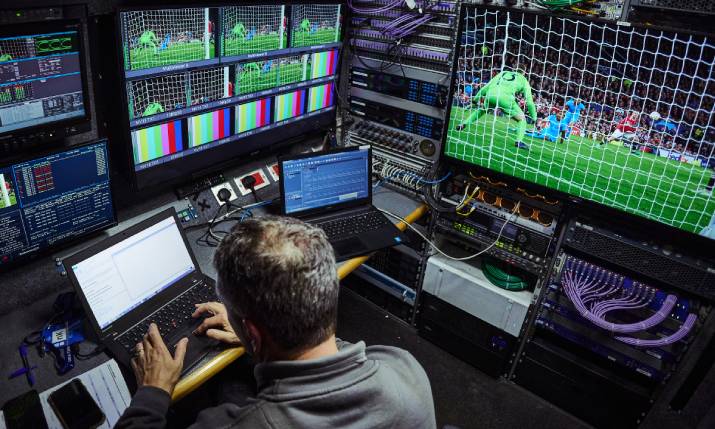Futureproofing sports broadcasting: BT Media and Broadcast on navigating the online shift
 By John Ellerton, BT Media and Broadcast head of futures and innovation.
By John Ellerton, BT Media and Broadcast head of futures and innovation.
This year promises to be one of the busiest on record in live sports broadcasting. We’re anticipating the return of golden sporting spectacles, including the grandeur of the Paris Summer Olympics, UEFA’s European Championships, Formula 1 races, and immense battles on tennis courts.
Broadcast audiences want to be brought ever closer to the action, to feel and experience every goal, sprint finish or epic rally, from the comfort of their homes, and increasingly from whatever device happens to be nearby. As discussed at the SVG Europe FutureSport conference late last year, we’ve witnessed a significant shift in sports viewership. It’s increasingly moving online, with consumers flocking to streaming channels, mobile devices, and short form content when away from the ‘big screen’. In fact, 37% of UK viewers [SVG Europe 2022] now watch sport on their phones. While this is in part due to the rise of TikTok and other social media platforms that prioritise short-form content, the opportunity of using social to promote the ‘main event’ is also hugely attractive for broadcasters.
Nevertheless, this shift demands more advanced technologies to ensure all types of live sport broadcasting, from English Premier League football to lower league rugby and everything in between, are as accessible and enjoyable as possible for a diverse set of viewers across the globe.
Potential stumbling blocks
With increasing access to content, broadcasters face challenges in bringing sport to audiences cost effectively. Broadcasters need to have the right equipment in their kitbag for efficient live content contribution and distribution, ensuring a reliable and secure service.
Capturing the authentic essence of live events becomes particularly challenging in smaller venues that often lack proper fibre infrastructure, and traditional broadcast solutions, such as geostationary satellite links often come with an expensive price tag.
As broadcasters strive to scale globally, new hurdles emerge, especially in ensuring that the sporting action reaches TVs and mobile screens across countries with varying local network infrastructures. The complexity of this task adds another layer to the already intricate landscape of live sports broadcasting.
Future of broadcast contribution
The evolution of broadcasting shows no signs of slowing. Private 5G networks and wireless IP links are emerging as solutions for the cost effective delivery of more sports content, expanding coverage across more venues, and numerous fixtures. Notably, they revolutionise on-field set ups by enabling the quick deployment of cameras and microphones, eliminating the need for time consuming cabling work.
At the forefront of this transformative evolution is the integration of wireless IP links with low Earth orbit (LEO) satellites. This innovative pairing presents a gamechanging approach to content transmission, enabling seamless connectivity from the most remote locations back to production galleries or the cloud.
A groundbreaking demonstration during the IBC Show in 2023 showcased the potential of this technology. BT and its partners BBC R&D, Neutral Wireless and Zixi successfully broadcasted a live feed over a Wireless IP link and then over both OneWeb and Starlink for the whole duration of the four day trade show. This exemplified the potential for delivering sports content via LEO satellites to overcome geographical broadcasting challenges and unlock new frontiers in sports content delivery.
Bringing sport to the masses
Sports broadcasters are the ultimate in pragmatist engineers. It’s always about ‘the best tool for the job’. And whether that’s dedicated dual and diverse fibre networking to distribute a tier one sporting event to a global audience, or something less costly for a lower tier event, finding the right solution that fits the audience’s expectation is paramount.
Increasingly for tier two and three events, internet-based connectivity is becoming trusted for primary distribution. Automatic repeat request (ARQ) technologies such as secure reliable transport (SRT) work over imperfect networks such as the internet. And the trade-off of latency for stability seems to be a price broadcasters find worth paying for lower tier content.
These ARQ technologies are transforming the way sport is distributed globally, enabling people worldwide to access content for the first time. Widely available platforms today that deliver live video over the internet, are key to achieving this.
It’s estimated [2020 ICT Enterprise Insights in the Media and Broadcast Industry] that nearly a third of media and broadcast businesses have moved their IP workflows onto cloud solutions, enhancing their existing infrastructure. Scaling up then becomes seamless when supported by a robust network provider that facilitates connectivity between networks and cloud-based distribution.
Leveraging the capabilities of the next generation facility line (NGFL) content can be directly connected to cloud platforms, enabling seamless distribution to affiliates and enabling social media clipping and content sharing.
Unlocking potential with the cloud
Private 5G networks, LEO satellites, ARQ and cloud each represent a disruptive innovation that has the potential to change the way that sports broadcasting is made. But what if we combine them all together?
Lower tier sports, cost effectively delivered to the audience becomes possible. Matches at venues with no fixed infrastructure can be televised and delivered to social and streaming as well as broadcast. But that’s not the only benefit.
The integration of wireless IP, private 5G, LEOs, ARQ and cloud has the potential to significantly improve cost effectiveness and efficiency for broadcasters. Empowering broadcasters to draw more eyes to screens and deliver content from anywhere, including hard to reach and off-net destinations.
In essence, the fusion of these technologies paves the way for a more adaptable and streamlined broadcasting ecosystem. This innovative approach ensures that broadcasters can effectively navigate the changing viewership landscape successfully. With strides like these, we stand at the threshold of an exhilarating journey into the future of broadcasting.

